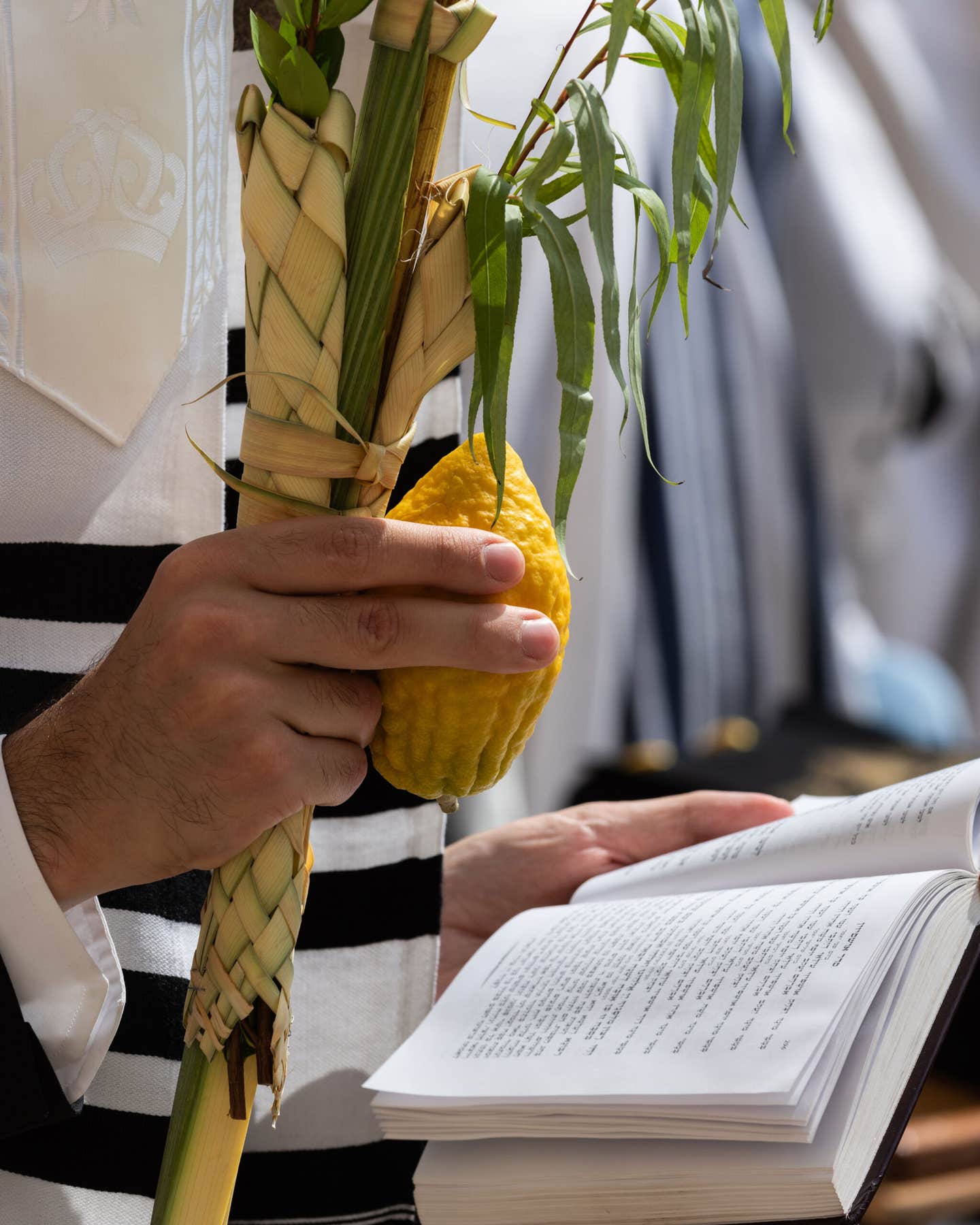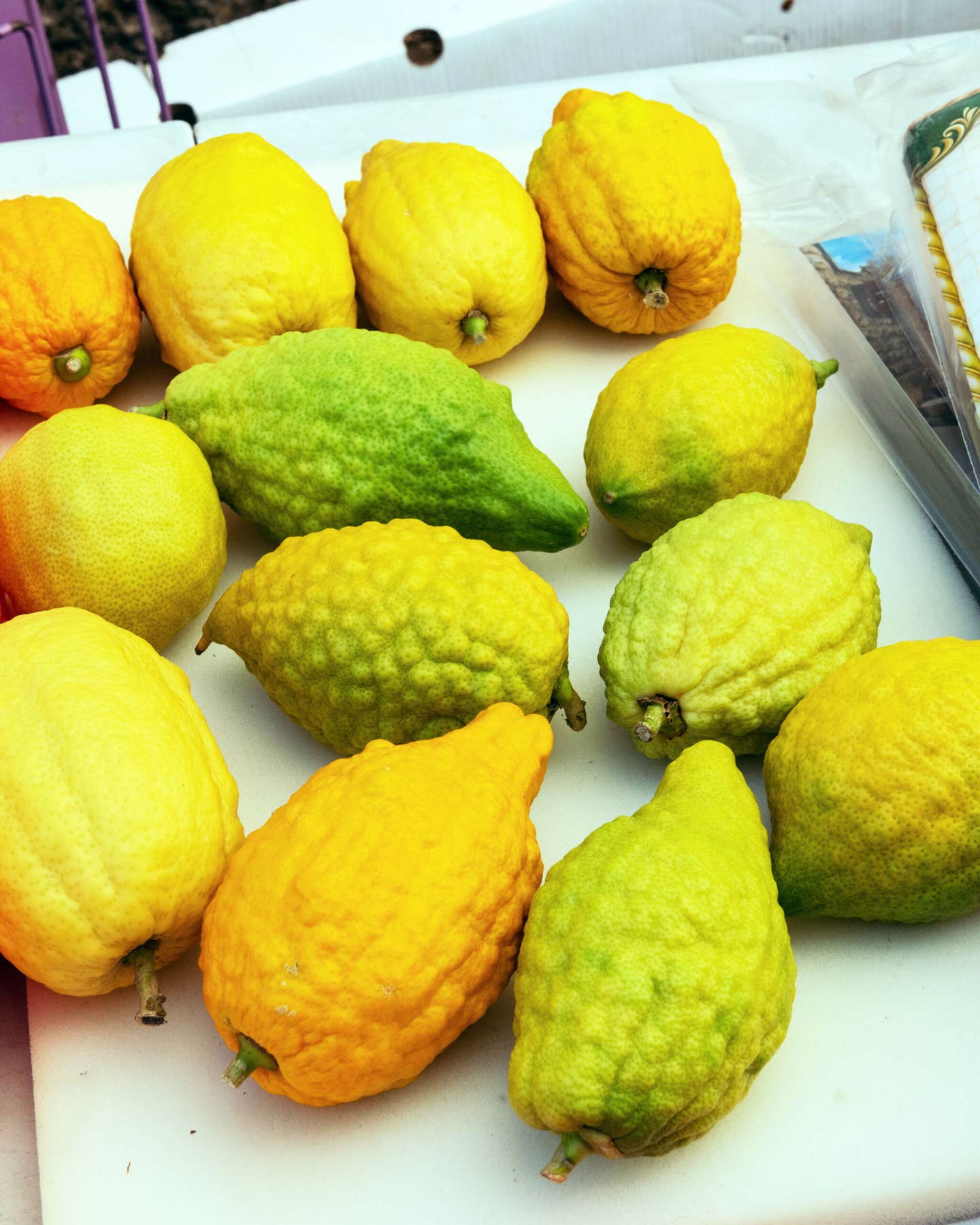This Remarkable Citrus Can Fetch Upwards of $1,000
The etrog graces Jewish Sukkot celebrations the world over, but what is its significance, and why is it so expensive?

On a recent walk around Williamsburg, Brooklyn, I happened upon a curbside stand where several Orthodox Jewish men were stooped over an etrog (the Hebrew word for citron, pronounced “ET-rog”). As they scrutinized the citrus fruit with a magnifying glass, they gently rubbed its knobby, bright yellow skin: If it was blemished in the slightest, the fruit was ruled out. Then they worked their way up to the pittom, Hebrew for the extruding top, and sniffed the citrus up and down to ensure it exuded an extraordinary aroma.
I can still remember my first whiff of the etrog’s ethereal scent, fruity and more perfumed than any citrus I’d encountered. From that moment, I was under its spell.
But why would a citron, with its thick, bitter pith and little edible pulp, be of such intense interest—and often fetch upwards of $1,000 apiece? Considering that an etrog’s lifespan is mere weeks, that price may sound unthinkable to the average grocery shopper, but as I’d soon learn, it’s hard to put a price on perfection.
The men in Brooklyn were in search of a perfect etrog for the harvest festival of Sukkot, celebrated this year from October 16 to 23. In early Judaism, the holiday was associated with the harvest of grapes, olives, figs, dates, and pomegranates. But for most modern-day Jews—from Buenos Aires to Belgrade to Boston—Sukkot celebrations the world over are synonymous with citrons.
Citrus medica, the Persian citron, while mostly grown today in Israel, is neither indigenous to the Holy Land nor mentioned in the Old Testament. Yet the fruit, resembling a large lemon and tasting like an especially bitter one, is regarded by some as the true forbidden fruit of the Garden of Eden.
David Karp, a citrus researcher at the University of California, Riverside, known in the food world as the “fruit detective,” tells a different story. Scientists have found that the etrog diverged from its two other primary species, the mandarin and the pomelo, 6 to 8 million years ago in Northeastern India and Southwestern China. From there it spread all over India, where it continues to be cultivated for its medicinal qualities, purportedly enhancing sexual potency. In Chinese traditional medicine, dried citron is used as a tonic to regulate qi, the life force. According to a Chinese folk belief, a woman who bit into an etrog would become pregnant within a year.

Around 500 B.C.E., the etrog reached Persia and the Mediterranean basin, and ultimately Jerusalem, to adorn Persian “paradise” gardens, according to Dr. Rabbi David Moster in his Etrog: How a Chinese Fruit Became a Jewish Symbol. The fruit was so enchantingly exotic that the sages concluded it was peri etz hadar, the “beautiful tree fruit” mentioned in Leviticus 23:40. “You shall take the product of hadar (beautiful fruit) trees, branches of palm trees, boughs of leafy trees, and willows of the brook, and you shall rejoice before your God seven days.” (“Hadar” in Hebrew means splendid, ornamental, and also citrus.)
With the destruction of the Second Temple in 70 C.E. and exodus of Jews from the Holy Land, an etrog business quickly developed. Traveling by boat, buggy, and on foot, merchants ventured to southern Europe and the Middle East in search of etrogs, then sold them as far afield as Eastern Europe, where religious Jews needed the warm-weather citrus to make the Sukkot blessing.
But that blessing doesn’t rely on the citron alone—it requires the lulav, or foliage described in the aforementioned biblical verse. On each of the seven days of Sukkot, the observant hold branches of myrtle, date palm, and willow trees in the right hand and the etrog in the left, then shake their arms while praying. When my children were little, that’s how we rang in each Sukkot—waving our lulav and etrog in the customary four directions in our backyard sukkah, the shelter Jews erect for the holiday symbolizing a biblical desert hut, before sitting down for a harvest meal.
Today, in Orthodox Jewish neighborhoods such as parts of Brooklyn or Mea Shearim in Jerusalem, there are etrog markets come September; you can also find affordable fruits online. Jewish tradition holds that a person who does the mitzvah of etrog-selection is blessed. Yossi Altein, 70, is one such purveyor (an “etroger,” in Yiddish) in Crown Heights, Brooklyn. Since 1929, his family has been shipping whole lots from Calabria to the United States, and before that, to Russia, from where his ancestors came.
“When the Lubavitcher rebbe came to America in 1929 and saw the Calabrian etrog, he was interested,” says Rabbi Altein. “For millennia, sages have told stories of visiting these wild groves.”
In Italy, he adds, people make etrog-scented shampoo and perfume. “When I was a little kid, my mother soaked the pith and the skin in honey for a few months, and I ate it like candy,” he says. That confection, also called cédrat glacé, is common in fruit cakes and liqueurs.
For my part, I’ll leave the etrog liqueur, fruit cakes, and jam to the professionals, but I look forward to potting my own plant on the terrace, savoring the aroma while watching the bumpy fruit grow throughout the year—and sometimes pondering its long journey.
Keep Reading
Continue to Next Story










